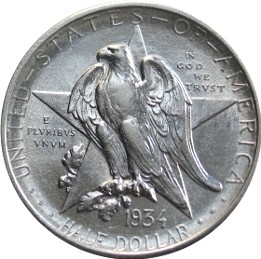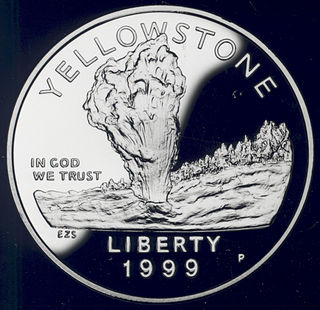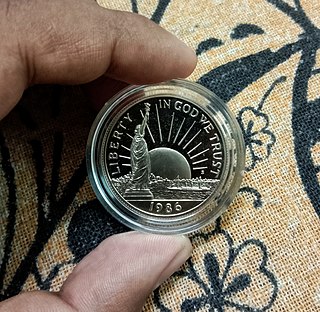
The United States Mint is a bureau of the Department of the Treasury responsible for producing coinage for the United States to conduct its trade and commerce, as well as controlling the movement of bullion. It does not produce paper money; that responsibility belongs to the Bureau of Engraving and Printing. The first United States Mint was created in Philadelphia in 1792, and soon joined by other centers, whose coins were identified by their own mint marks. There are currently four active coin-producing mints: Philadelphia, Denver, San Francisco, and West Point.

The dime, in United States usage, is a ten-cent coin, one tenth of a United States dollar, labeled formally as "one dime". The denomination was first authorized by the Coinage Act of 1792. The dime is the smallest in diameter and is the thinnest of all U.S. coins currently minted for circulation, being 0.705 inches in diameter and 0.053 in (1.35 mm) in thickness. The obverse of the current dime depicts the profile of President Franklin D. Roosevelt and the reverse boasts an olive branch, a torch, and an oak branch, from left to right respectively. As of 2011, the dime coin cost 5.65 cents to produce.

A double eagle is a gold coin of the United States with a denomination of $20. The coins are 34 mm x 2 mm and are made from a 90% gold and 10% copper alloy and have a total weight of 1.0750 troy ounces.

The Franklin half dollar is a coin that was struck by the United States Mint from 1948 to 1963. The fifty-cent piece pictures Founding Father Benjamin Franklin on the obverse and the Liberty Bell on the reverse. A small eagle was placed to the right of the bell to fulfill the legal requirement that half dollars depict the figure of an eagle. Produced in 90 percent silver with a reeded edge, the coin was struck at the Philadelphia, Denver, and San Francisco mints. As of December 30, 2021, the melt value of the $0.50 coin was approximately $8.37.

The West Point Mint is a U.S. Mint production and depository facility erected in 1937 near the U.S. Military Academy in West Point, New York, United States. As of 2019 the mint holds 22% of the United States' gold reserves, or approximately 54 million ounces. The mint at West Point is second only to the gold reserves held in secure storage at Fort Knox. Originally, the West Point Mint was called the West Point Bullion Depository. At one point it had the highest concentration of silver of any U.S. mint facility, and for 12 years produced circulating Lincoln cents. It has since minted mostly commemorative coins and stored gold.

The quarter eagle was a gold coin issued by the United States with a denomination of two hundred and fifty cents, or two dollars and fifty cents. It was given its name in the Coinage Act of 1792, as a derivation from the US ten-dollar eagle coin. Its purchasing power in 1800 would be equivalent to $71.12 in 2015 dollars.

The Washington quarter is the present quarter dollar or 25-cent piece issued by the United States Mint. The coin was first struck in 1932; the original version was designed by sculptor John Flanagan.

The Texas Centennial half dollar commemorative coin was minted to honor the Centennial of Texas's independence from Mexico. Early in the administration of President Franklin Delano Roosevelt, on June 15, 1933, Congress passed an act to authorize the coinage of silver half dollars "in commemoration of the one hundredth anniversary in 1936 of the independence of Texas, and of the noble and heroic sacrifices of her pioneers, whose revered memory has been an inspiration to her sons and daughters during the past century." This was the first of over two dozen commemorative bills that would become reality during Roosevelt's tenure. The legislation provided that "no more than one and a half million pieces" be created on behalf of the American Legion Texas Centennial Committee, located in Austin in that state.

The United States Commemorative Coin Act of 1996 is a United States federal law which established a commemorative coin program within the United States Mint in 1996. In addition, the law specifically authorized commemorative coins to observe the 150th anniversary of the death of Dolley Madison, to honor George Washington, the 125th anniversary of the establishment Yellowstone National Park, and the 50th anniversary of Jackie Robinson's racial desegregation of Major League Baseball. It also established commemorative coin fundraising programs for the Black Revolutionary War Patriots Memorial, Franklin Delano Roosevelt Memorial, and National Law Enforcement Officers Memorial.

The United States Sesquicentennial coin issue consisted of a commemorative half dollar and quarter eagle struck in 1926 at the Philadelphia Mint for the 150th anniversary of American independence. The obverse of the half dollar features portraits of the first president, George Washington, and the president in 1926, Calvin Coolidge, making it the only American coin to depict a president in his lifetime.

The Roosevelt dime is the current dime, or ten-cent piece, of the United States. Struck by the United States Mint continuously since 1946, it displays President Franklin D. Roosevelt on the obverse and was authorized soon after his death in 1945.

The Yellowstone National Park silver dollar is a commemorative coin issued by the United States Mint in 1999. Proceeds benefitted Yellowstone National Park and other national parks via the National Park Foundation.

The Statue of Liberty commemorative coins are a series of commemorative coins which were issued by the United States Mint in 1986.
The United States Constitution Bicentennial commemorative coins are a series of commemorative coins which were issued by the United States Mint in 1987.
The Christopher Columbus Quincentenary commemorative coins are a series of commemorative coins which were issued by the United States Mint in 1992 for the Columbus Quincentenary.
The Mount Rushmore Anniversary commemorative coins are a series of commemorative coins which were issued by the United States Mint in 1991.
The Civil War Battlefields commemorative coins are a series of commemorative coins which were issued by the United States Mint in 1995.

The George Washington gold half eagle is a commemorative coin issued by the United States Mint in 1999, the 200th anniversary of Washington's death.















